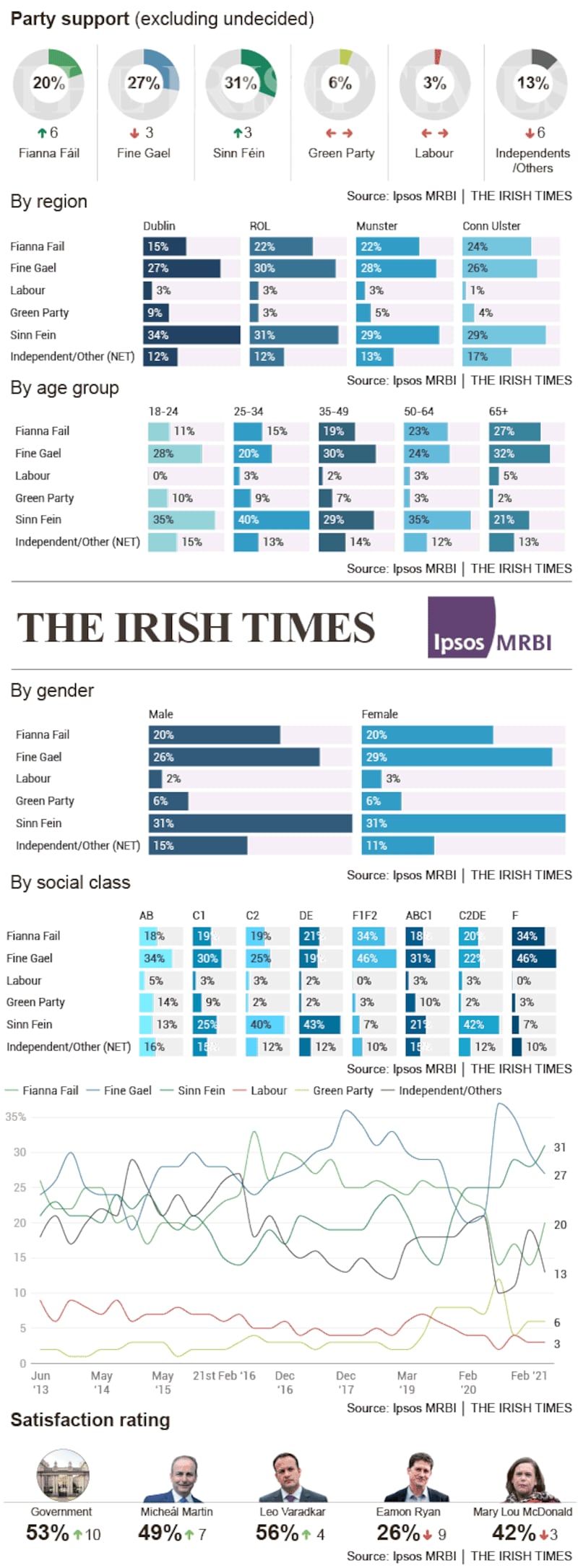Sinn Féin is on top again, with its highest-ever rating in an Irish Times/Ipsos MRBI opinion poll of support for the parties. Our latest such poll shows Sinn Féin on 31 per cent (up three points), ahead of Fine Gael, which has slipped three points to 27 per cent.
Fianna Fáil remains some way adrift of Sinn Féin and Fine Gael, although it has closed the gap considerably in this June poll, jumping six points to 20 per cent. The Green Party (on 6 per cent) and Labour (on 3 per cent) are unchanged. Independents and smaller parties combined attract 13 per cent of the vote (down six points). Within this bloc are People Before Profit/Solidarity (on 2 per cent) and Social Democrats (on 2 per cent).
Fieldwork for our June poll took place on Monday and Tuesday of this week among 1,200 potential voters across 120 sampling points covering every constituency.

As we begin to emerge from the pandemic, there is a sense of optimism (or relief) that is reflected in public opinion on how the Government is running the country. Satisfaction with the Government’s performance is up 10 points to 53 per cent; not quite the early-pandemic high of 72 per cent, but still the second-highest such rating for any government in almost 20 years.
The Government’s competence in navigating the pandemic has not been enough to stem the rising tide of Sinn Féin. The party has reached a new high of 31 per cent, earning pole position for only the second time since The Irish Times and Ipsos MRBI began political polling almost 40 years ago. The landscape has truly changed.
Sinn Féin has always performed well among younger voters, but lately it has begun to make inroads into the older age cohorts. In this latest poll, Sinn Féin attracts support from 28 per cent of over-50s, rivalling Fine Gael (28 per cent) and outpolling Fianna Fáil (25 per cent) among this age group.
Regionally, support for Sinn Féin is broadly based (34 per cent of Dublin voters back the party; 31 per cent of voters in the rest of Leinster; Munster 29 per cent; Connacht/Ulster 29 per cent).
Socio-economic divide
Increasingly the battle between the larger parties is being fought along socio-economic lines. Among the professional/managerial classes (the As and the Bs), Fine Gael is clearly the preferred choice on 34 per cent of the vote, compared with 18 per cent for Fianna Fáil and 13 per cent for Sinn Féin.
At the other end of the class spectrum, among working-class (C2DE) voters, the tables are turned. Among the C2DE socio-economic group, Sinn Féin dominates with 42 per cent of the vote, leading Fine Gael (on 22 per cent) and Fianna Fáil (on 20 per cent) by a considerable margin.
Among voters from farming backgrounds (the F grouping), Fine Gael (46 per cent of the vote) and Fianna Fáil (34 per cent) have the pitch almost to themselves, but the population of Irish farming households is small and shrinking, and consequently no longer sufficient to buttress performances at the national level.
Support for Fine Gael continues to drift, according to this latest poll. With support for the party having peaked at 37 per cent nationally during the first wave of the pandemic, some slippage was to be expected.
A plus for Fine Gael is that it remains significantly ahead of its 2020 general election performance of 21 per cent. Furthermore, it can claim to have the most popular party leader in Leo Varadkar, whose satisfaction rating is up four points to 56 per cent.
Fianna Fáil has recorded something of a surge in this latest poll, albeit off a low base, with its gain of six points. In Dublin, support for the party has bounced from 8 per cent to 15 per cent, a welcome gain in advance of the Dublin Bay South byelection. Despite these gains, however, Dublin remains the regional weak link for Fianna Fáil, with the party on firmer ground in the rest of Leinster (with 22 per cent of the vote there), Munster (22 per cent) and Connacht/Ulster (24 per cent).
Satisfaction with Micheál Martin has also jumped, up seven points to 49 per cent, his highest-ever rating as party leader.
Greens’ fortunes
The Green Party remains on 6 per cent support, but its rating varies noticeably by demographic. For example, among young (under 35) Dubliners, 17 per cent would choose a Green candidate if there were an election tomorrow – something to note in advance of the Dublin Bay South byelection next month. The party also performs strongly among the AB social class, attracting 14 per cent of the vote here.
Labour is unchanged on 3 per cent nationally, and the party is also on 3 per cent in Dublin (down two points). Age-wise, the party skews somewhat older, a leaning which seems to have emerged in recent years as its franchise contracted.
The combined grouping of Independents/Others has fallen back nationally with its six-point drop to 13 per cent. Arguably the pandemic has been a national phenomenon, yielding few opportunities for local issues and Independent politicians to cut through. This will change given time.
People Before Profit/Solidarity, Social Democrats and Aontú (on 1 per cent) make up the bulk of the smaller party share within the Independents/Others grouping.
This latest Irish Times/Ipsos MRBI poll suggests the public, by and large, endorses the approach taken by the Government to managing the pandemic, with the combined vote share of the Government parties now greater than that achieved in the last election. Looking ahead, convincing the public to embrace the changes needed to get the public finances back on track will be challenging. Eaten bread is soon forgotten.











